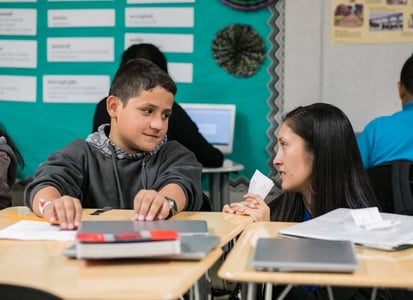TOOLKIT
Transform Discipline into a Learning Opportunity

Restorative Mindset
Learn More About Restorative Justice
Restorative Justice (RJ) is an approach that encompasses a wide range of ideas and practices that range from community building circles to peer mediation and beyond. Here are a few resources to help you get started.
- Learn More: Restorative Justice in School [Cult of Pedagogy]
- Resource: CPS Restorative Practices Guide and Toolkit [Chicago Public Schools]
- Resource: Restorative Conversations [Turnaround for Children]
Reflect On Your Own Mindset
Embracing a restorative mindset means placing relationships and trust at the center of your community and considering how members of the community are responsible to and for each other. It also means that when members of the community cause harm, the focus is on repairing that harm, and working toward healing through honest dialogue. How does this intersect with other values you hold? What types of beliefs do you hold that reflect or conflict with these ideas?
- Resource: Restorative Justice Mindset Survey [Umoja Student Development Corporation]
- Resource: Reflecting on Identity, Values and Beliefs
Share With Students and Families
As members of the classroom community, students and families also have an interest in understanding and shaping the way discipline is approached in the classroom. Try planning short lessons to introduce Restorative Justice to students and to get their input on the practices that affect them. Share information about restorative justice with families and invite them incorporate restorative language to their discipline practices at home and provide feedback.
- Resource: Shifting Student Mindsets Discussion Guide [Turnaround for Children]
- Resource: Making Things Right [Chicago Public Schools]
- K-2 Resource: Restorative Practice Books [Positively Learning]
- K-12 Resource: Recommended Reading [Trudy Ludwig]
- Home Resource: Restorative Justice Handout for Families -- English | Spanish
Restorative Conversations
Use Empathetic Listening
Empathetic listening is the practice of truly listening to the thoughts, feelings, and needs of another person, and making an effort to understand the other person’s perspective. Empathetic listening is active; it’s a focused effort to ensure that the speaker feels that they are understood and valued without judgment.
- Strategy: Empathetic Listening [Chicago Public Schools]
- Strategy: Talk One-On-One With a Student [PBIS World]
- Resource: Shifting to Restorative Language
Use Inquiry
Inquiry is a practice of asking restorative questions, which are non-judgmental ways of prompting someone to consider the feelings of others, the impact of their actions, and what can be done to make things right.
- Resource: Restorative Conversation Starter Questions and Phrases [Turnaround for Children]
- Resource: Examples of Restorative Questions [Alternatives, Inc.]
Explore Impact
One way to help students understand the impact of their actions is by using “I” statements. “I” statements express feelings and convey how the speaker was affected, which helps strengthen relationships and build understanding of how one person’s actions affect the larger community.
- Learn More: Focus on Solutions [Positive Discipline]
- Video: Restorative Justice - Circle [Kyle Smith]
- Resource: “I” Statements [Chicago Public Schools]
- Resource: A Teacher’s Flow Chart for Restorative Discipline [Chicago Public Schools]
Community Norms
Co-create Norms
Norms are behavioral standards that are created and agreed to by all community members. In contrast to teacher-created rules about what students should and should not do, norms apply to every individual in the classroom, encourage positive behaviors, are few in number, and encompass many different habits. Facilitating a process of co-creating norms with students puts students at the center of the classroom. Students are able to offer how they want to be treated by others, and create an accountability system that holds all parties of the classroom responsible.
- Learn More: The Science Behind Classroom Norming [Edutopia]
- Resource: Co-Creating Classroom Norms Slide Deck
Revisit Norms
You can always return to your norms to revise them or to encourage students to practice them better. Remind students about your norms by asking them to reflect daily about which norm they embodied that day, or which norm they can improve on.
- Resource: Revisiting Norms Reflection